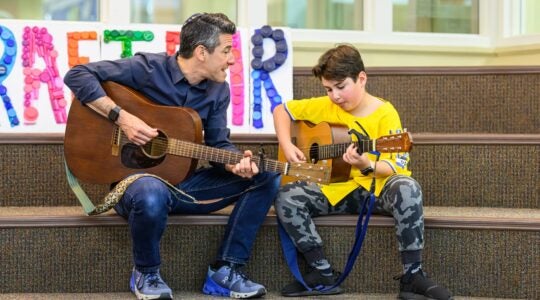If you had signed up for The Fundermentalist newsletter, you could have read this last week:
Some 4,000 Chabad-Lubavitch emissaries came home to their Crown Heights base for the annual "kinus" earlier this month — a conference that includes a week of professional development culminating with a grand banquet Nov. 15 at the Brooklyn Armory.
If you can somehow score an invite, the kinus is not to be missed, if only for the sheer spectacle, with most of the Chabad shluchim on hand.
To borrow from Tablet’s "By the Numbers" feature, think 600 tables, 4,000 black hats, 10,000 challah rolls, 24,000 inches of beard, a ton or so of meat and six women. Four thousand men dance the hora at one time for about a half-hour after the emcee holds a roll call of the cities and countries where Chabad has outposts.
Over the last year, Chabad has been hit as hard as any other Jewish nonprofit system, but the rabbis with whom I spoke at the armory seemed steadfast in holding to their mission to serve as the unofficial outreach arm of the Jewish people.
Chabad houses typically are bare-bones operations as far as organizational infrastructure, consisting most often of the rabbi and his wife. The most developed operations have a few teachers and program officers.
Generally run on shoestring budgets to match, Chabad houses spend more on educational elbow grease and personal interaction than on expensive programming. It’s part of the reason Chabad has been one of the most successful Jewish identity-building projects in modern history.
Chabad’s director of education, Rabbi Moshe Kotlarsky — the night’s emcee — declared publicly that not one house has closed since the recession (though there was a report earlier this year that four Chabad houses in Florida are in foreclosure). But most houses, which generally receive no financial support from Chabad central in Brooklyn, have seen a cut in donations and been forced to adapt.
Rabbi Chaim Bruk, for instance, started a Chabad in Bozeman, Mont., two years ago and said he has seen a 30 percent dip in funding. Chabad houses don’t charge membership fees, so Bruk started what he is calling a Chai Club. He asked his regulars to give whatever they could each month to the Chabad in addition to their annual donations. Now he has 25 people giving $18 to $400 a month.
It’s helping to keep his outpost, which has a $150,000 annual budget, afloat.
Bruk hasn’t had to cut any programming. But he also realizes there are projects he completed before the recession hit — like building the state’s first mikveh — that never would have attracted sufficient funding in today’s climate. And this is in Montana, which has been less affected by the recession than most anywhere else in the country.
At Washington University in St. Louis, the campus Chabad House has seen subtle changes, says its director, Hershey Novack. For instance, at the free weekly Shabbat dinners, students are being served plain white rice instead of jasmine rice — at about one fifth the cost. Also, Novack has had to put off some maintenance work on his building.
Novack, who has been growing the Washington U. Chabad for seven years, suddenly finds himself as the only full-time rabbi on campus after the Hillel had to let go its rabbi for financial reasons, he said.
That means Novack is working more than ever. And like all of the Chabad rabbis with whom I spoke, he said he is spending more time than ever on fund raising. A number of the workshops at the conference last week focused on dealing with economic realities, and kinus speakers repeatedly mentioned economic hardships.
But Chabad may have an advantage over a lot of nonprofits: The rabbis dispersed all over the world believe they are on a mission from God and remain highly motivated to do their fulfilling work. That is why they were selected as shluchim in the first place.
"There’s just a sense of responsibility," Novack said.
Keeping Mumbai victims’ names alive: An interesting side note to the Chabad gathering: In the year after emissaries Rabbi Gavi and Rivky Holtzberg were killed by terrorists who struck the Chabad house in Mumbai, some 500 Lubavitcher children have been named Rivky or Gavi, according to The New York Jewish Week.
JTA has documented Jewish history in real-time for over a century. Keep our journalism strong by joining us in supporting independent, award-winning reporting.





